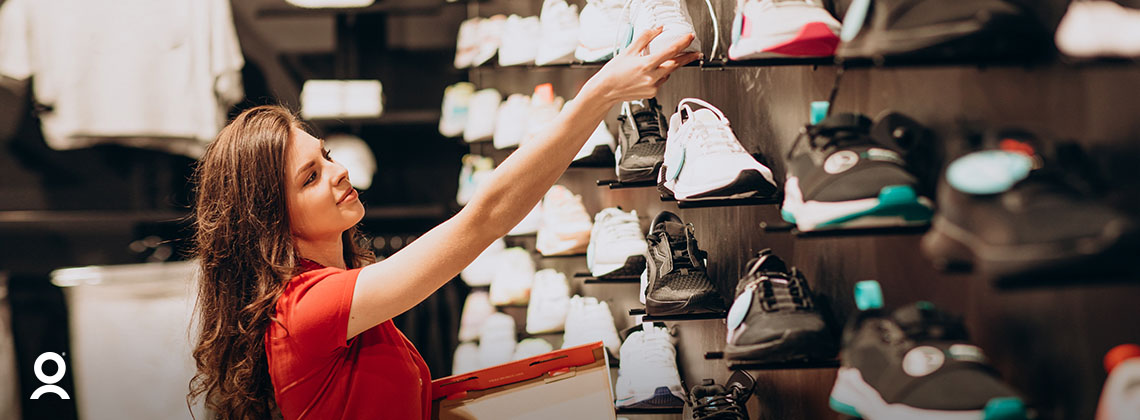5 Ways to Engage Retail Employees and Boost Store Performance

So, what does an engaged employee look like, and how do you motivate them effectively?
Well, a store associate who is friendly, knowledgeable, and enthusiastic about their job will leave a better impression on their customers and co-workers than one who clearly can’t wait for their shift to end—and we all know which one a customer would prefer to interact with.
But more than just making for pleasant customer and co-worker experiences, an engaged employee who feels valued by their company can also boost overall store performance by increasing productivity, attendance, and sales.
According to recent Gallup research, higher employee engagement also results in:
- Higher profitability
- Higher customer ratings
- Fewer safety incidents
- Less turnover
- Less shrinkage
So instead of letting unengaged employees drag down the store atmosphere, team morale, and your company’s bottom line, here are some tips to raise engagement levels in your stores and create a positive employee experience.
How to Engage Store Employees
1. Keep the Lines of Communication Open
It’s important to keep channels open between all levels of the company. If HQ sends down a new set of best practices to regional managers, but the updated information never makes it to the employees on the store floor, they can’t follow the rules. It’s imperative, then, that the higher-ups can share new information to their retail workers quickly and in a clear, easy to understand, and up-to-date way.
It’s also important that the flow of communication is two-way, allowing store associates to clarify information and ask any questions they might have. The more they know about the company’s brand and products, the better equipped they are to sell and convey those brand ideals and information.
When employees are given the best information possible, they can do their best work.
2. Set Clear, Meaningful Goals
According to McKinsey & Company, employees who “feel that their purpose is aligned with the organization’s purpose” are more productive, healthier, more resilient, and more likely to stay with the company. So, managers should try to engage store associates by giving their work meaning.
Explaining the “why” behind everyday tasks—whether it’s greeting customers and letting them know about a new sale or telling your employees about COVID-19 precautions—can help them see their role in the company’s bigger picture, and that makes them feel like a valuable part of the team.
For example, store associates may be frustrated with a new type of price sticker that has been sent from HQ. It’s more difficult to peel off of items, but it is manufactured by an environmentally-conscious company and contributes to HQ’s pledge to make stores more “green.” Once the employees on the floor realize that there is a good reason behind the change, they’ll be more likely to accept it graciously—and maybe even make personal adjustments to further contribute to the company’s common goal.
3. Provide Ongoing, Constructive Feedback
Employees can’t exceed expectations without having firm expectations in place. But even once the rules have been clearly communicated to them, encouragement and constructive criticism can go a long way in developing engagement.
Annual performance reviews have been the feedback of choice for decades, but ongoing, on-the-job learning can make an even bigger impact.
The Harvard Business Review argues that pointing out positive interactions can do more to achieve success than theorizing about mistakes that have been made in the past: “Excellence is an outcome, so take note of when a prospect leans into a sales pitch, a project runs smoothly, or an angry customer suddenly calms down. Then turn to the team member who created the outcome and say, ‘That! Yes, that!’”
Essentially, when store associates are acknowledged for doing something well, they are more likely to continue doing it. This allows them to take pride in their work, while delivering positive business outcomes.
4. Recognize and Reward Deserving Employees
Has an employee been going above and beyond? Maybe they’re consistently helping others without being asked to, or smashing weekly sales targets? Then tell them they are doing great!
In addition to verbal praise, rewards can provide a powerful incentive for store associates to become more engaged. Recognizing success with tangible, monetary rewards like a raise, bonus, or an extra vacation day can really ignite a flame under employees.
But smaller, more frequent gestures are also a great tool.
If you’re looking for retail staff incentive ideas, free snacks and games during breaks can boost everyone’s morale, while star performers or the “employee of the month” could be treated to a little something extra like lunch, event tickets, or even some one-on-one mentoring.
Even something as simple as saying “you’re doing a great job,” whether in-person or on your company’s in-store communication platform, can go a long way.
5. Focus on Future Development
Millennials account for nearly half of the workforce (and will account for nearly 70% by 2025)—and they’re hungry to learn more. The generation of employees born between 1982 and 2000 list career progression and training development as the top traits they look for in an employer. Yet, they remain statistically the least engaged demographic of any workers (only 29% say they are engaged at their job).
Therefore, employees (especially Millennials) are more likely to get engaged and stay loyal to your company if you can provide continuous learning.
Training shouldn’t be a one-time thing upon hiring; look for opportunities to train staff on procedures and products that will make them better at their job and maybe even prepare them for a promotion. There are tons of training ideas for retail staff out there, you just need to be a little creative—and mobile technology can make it easy to bring learning to employees right where they are working.
Find out how WorkForce Suite’s Employee Experience can keep your team connected and improve engagement in a retail setting. Schedule a demo to learn more.
Subscribe to The WorkForce Blog
Learn the art and science of maintaining productive, happy, engaged employees.
Discover More
Embedding an ‘Eyes Wide Open’ Mindset Into HR Technology Selection
Gartner guides teams responsible for deciding on their organization’s next HR technology investment to set themselves up for success.
5 Workforce Management Secrets to Thrive in 2021 and Beyond
Download this eBook to learn the 5 secrets that will help your organization shift from surviving to thriving now and in the future and learn how the right workforce management solution can empower your initiatives.
Reshaping Workforce Management Strategies to Meet Growing Employee Expectations
See how evolving preferences and pivotal factors have led to a transformative shift in workforce expectations.



